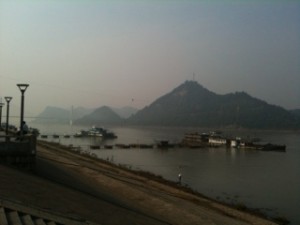Yichang – Up Through the Gorges in 1935
Posted: June 23rd, 2013 | 1 Comment »I spent a couple of days in Yichang this week and thought I’d dig out a few reminiscences about the place from the great master Old China Hand, Carl Crow. Crow journeyed up the Yangtze to Sichuan in 1935 partly for a spot of tourism and to see the Three Gorges and partly to see some advertising clients of his up in Sichuan. He decided (though a new aeroplane service was available) to make the voyage by boat….
The Yangtse at Yichang this week…
“As usual with Carl what should have been a routine journey to Sichuan turned into a more informative trip than he could have hoped for. In the mid-1930s Sichuan was still considered hopelessly remote. The inland treaty port of Yichang in Hubei, the ‘Gateway of the Gorges’, was a thousand miles from Shanghai while steam navigation went only as far as Chongqing, a further 410 miles upriver from the rapids at Yichang through the famous Three Gorges. Crow travelled by Yangtze River Steamer from Shanghai with Yangtze White Dolphins dipping and diving in the boats wake. The steamer departed in the late afternoon, passing Zhenjiang), a city noted for the quality and the all-pervasive smell of its locally produced vinegar, in Jiangsu, at the junction of the Grand Canal with the Chang River and arrived in Nanjing a day later. Though the new rail service was only an overnight journey Crow considered the standard of hotels in Nanjing so poor he preferred to stay on the steamer. From Nanjing it was a further journey upriver through the commercial centre of Wuhu, the tea-producing town of Kiukiang and Anking with its famous Wind Moving Pagoda for four days before arriving at Hankow and the junction of the Yellow and the Yangtze Rivers. Along with the famous White Dolphins Crow also glimpsed the miniature Yangtze alligators as well as experiencing the famously volatile currents, known as chow chow waters by the ship’s captains, north of Anqing.
Between Shanghai and Hankow the Yangtze was broad and deep and in the summer season when the river was bulging with melting snow waters from Tibet navigable by ocean going vessels. However, above Hankow the Yangtze changed its nature considerably. The so-called middle Yangtze, between Hankow and Yichang, became narrow, crooked, sallow and far harder to navigate meaning that passengers had to transfer to smaller passenger boats for the remainder of the journey which could only be undertaken during daylight hours as by night the river was simply too treacherous.
Hankow to Yichang was a voyage of 400 miles and took longer than the 600 miles from Shanghai to Hankow. At Yichang the middle Yangtze became the upper Yangtze and a further transfer to an even smaller passenger boat was required to proceed and complete the 410 miles to Chongqing. The small vessels that traversed the Yangtze between Yichang and Chongqing were highly powered in proportion to their size to deal with the swift churning currents and rapids. It was still often the case that no amount of engine power was of use and the boat had to be steered through the Gorges, and ominously named spots like the Little Orphan Channel, using towlines pulled by several hundred Sichuan peasants, or Trackers, dragging the boat by walking along narrow paths cut into the cliff face on either side of the torrent below. The upper Yangtze was at that time known as a “graveyard for ships†and, according to Crow, carried the highest maritime insurance rate in the world. As Crow’s ship inched up through the Gorges he could see the funnels of sunken ships dotting the water to remind passengers of just how unforgiving the Yangtze could be.”
From my biography of Crow – A Tough Old China Hand

Gubeikou Great Wall of China 101 National Road Miyun, Beijing, China.. Gubeikou Great Wall of China is one of the best, though least visited, sections of the wall. If you want to get away from crowds and tourist hawkers, then go here. This area of the wall is much more remote, for a tourist, than others. Gubeikou’s distance from Beijing and proximity to Jinshanling and Simatai mean that Guibeikou is often overlooked. This site is rated AAAA on China’s national tourism scale.